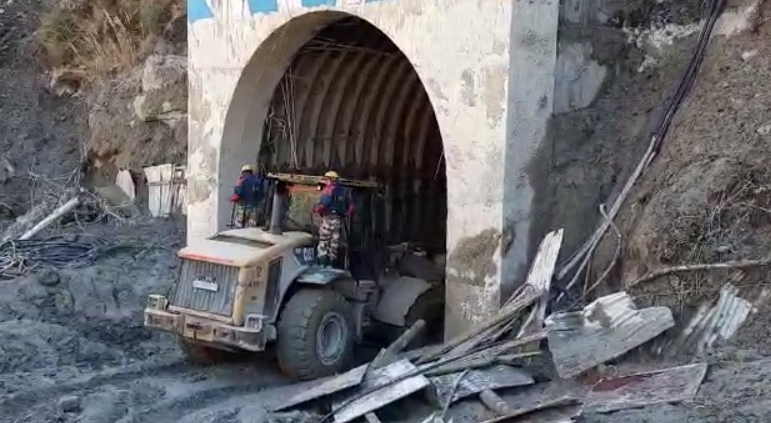

Rescue operation by ITBP at Tapovan
<p>
The latest tragedy in Uttarakhand resulting in more than 200 people missing definitely requires introspection on the development of the hill State. The damage of four hydropower stations, including NTPC-owned Tapovan Vishnugad, the private project of Rishi Ganga, Pipal Koti of State-owned THDC, and Jaypee Group&rsquo;s Vishnuprayag has brought construction of big dams into sharp focus.</p>
<p>
Uttarakhand&rsquo;s main source of development is hydel power. The potential of the former is to a tune of 20236 MW. Highlighting this, a World Bank report has termed it as the State&rsquo;s most important strategic assets. Obviously, the State and its residents, deem it fit to tap this potential not just for their betterment but also for the larger good of the nation as they cater to energy needs of residences and industries in other States and mega cities.</p>
<p>
But given its rather fragile ecology, are big dams in Uttarakhand sustainable?<br />
<br />
According to the Indian metrological department, the Bureau of Indian Standards categorises Uttarakhand as a V seismic zone, the most active zone. The Indian plate, a part of the Indo-Australian plate, colliding with the Eurasian plate, has created several fault lines, making the<br />
region earthquake prone.<br />
<br />
That said, new technology is being consistently developed to overcome this hazard. A position paper by the International Water Power &amp; Dam Construction, states that &ldquo;technology is available for building dams and appurtenant structures that can safely resist the effects of<br />
strong ground shaking. Storage dams that have been designed properly to resist static loads prove to also have significant inherent resistance to earthquake action. Many small storage dams have suffered damage during strong earthquakes. However, no large dams have failed due to earthquake shaking.&rdquo;<br />
<br />
Yet, the paper adds that&nbsp; &ldquo;there are still uncertainties about the behaviour of dams under very strong ground shaking, and every effort should be made to collect, analyse and interpret field observations of dam performance during earthquakes.&rdquo;<br />
<br />
Seized of this danger, the Government&rsquo;s Uttarakhand Vision 2030, is eyeing green power for the State. The vision has set broad goalposts of meeting 15 per cent energy demand from renewable sources instead of present 3.2 per cent and importantly save 25 per cent energy consumption to meet Government of India&rsquo;s commitment to meet 40 per cent of energy requirements from renewable energy.<br />
<br />
For the former, the micro hydel, solar, co-gen, biomass will be tapped. To meet the second target, there will be replacement of CFLs and incandescent lamps with LED bulbs, switchover to energy-efficient devices, installing of solar energy heating systems in Government offices, schools, colleges, hostels, housing complexes, hotels and hospitals and industries requiring hot water for processing; and implementation of energy conservation building codes among others.<br />
<br />
The way forward for Uttarakhand is Small Hydro Power (SHP) projects. Projects up to 25 MW station capacities are categorized as SHP, and these provide clean energy. Besides requiring minimal submergence, rehabilitation and minimal impact to environment they accrue other advantages like promoting local industries in remote areas and assisting self-employment.<br />
<br />
The region with several rivers and canals spells tremendous potential which is enhanced by the availability of ice fed and rain fed rivers and natural incline in the state. SHPs can play a critical role in national energy scenario and, in particular, for remote and inaccessible areas. For example, the remote area of Badrinath, power supply is through an SHP.<br />
<br />
The State needs to take a close at sustainable livelihoods aspect too, to enhance social and human development which is equitable while conserving natural resources and environment. The emphasis will need to move to horticulture, sustainable tourism and opting for MSME. This coupled with SHP and information technology will spur growth.</p>
The Trump administration announced on Wednesday that it will continue its efforts to prevent advanced…
External Affairs Minister S Jaishankar met with German Chancellor Friedrich Merz in Berlin on Friday…
The Central Tibetan Administration (CTA) launched a Month-long Panchen Lama Awareness Program aimed at educating…
India's Ambassador to Russia, Vinay Kumar, on Friday, briefed the all-party parliamentary delegation, led by…
Prime Minister Narendra Modi on Friday addressed the inaugural ceremony of the Rising North East…
Chat GPT's parent company Open AI on Thursday announced a partnership with the United Arab…